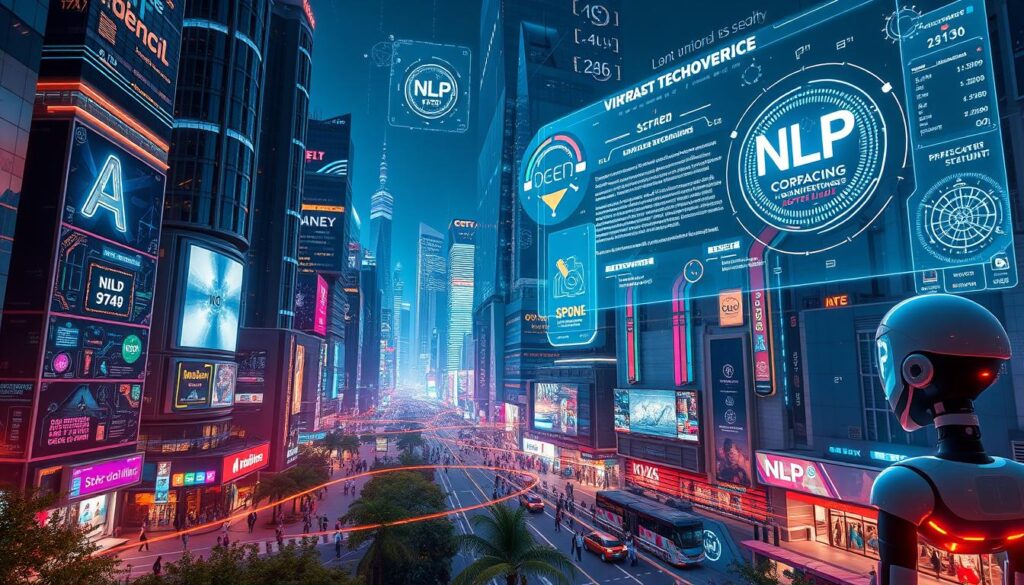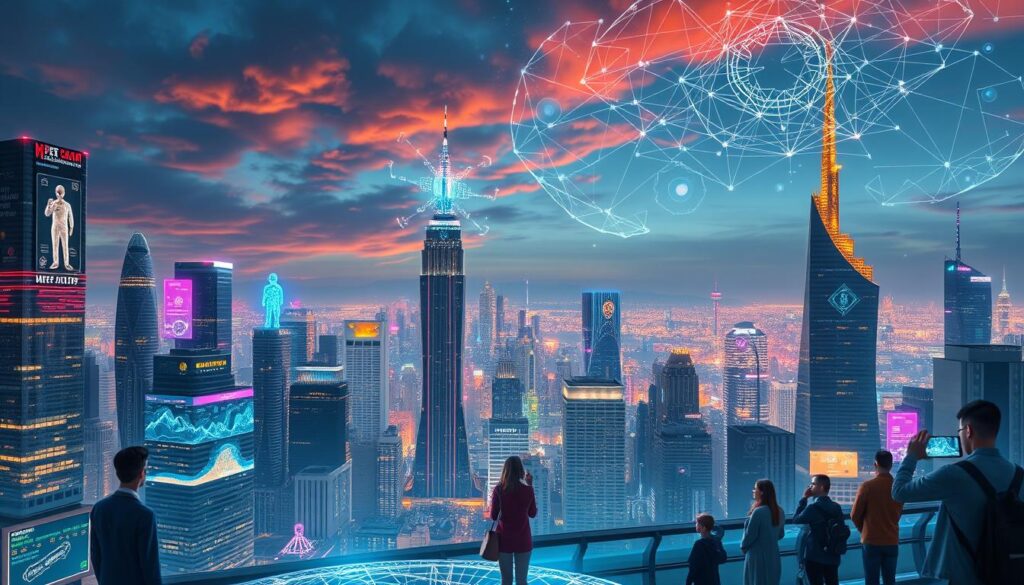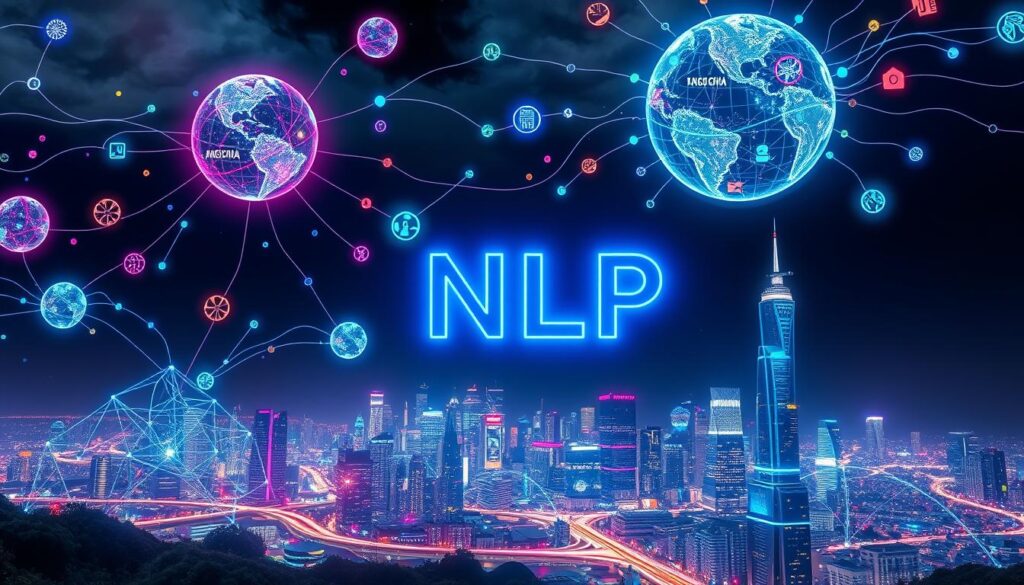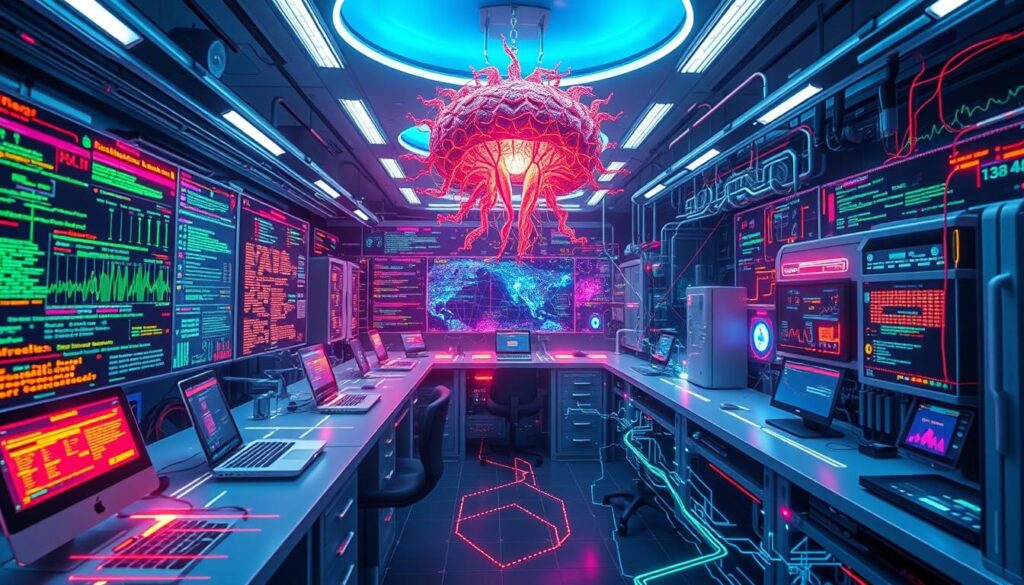“The most important thing in communication is hearing what isn’t said.” – Peter Drucker. This quote shows how Natural Language Processing (NLP) technology is changing our world. By 2025, we’ll see big changes with tools like OpenAI’s GPT-4 and Google’s Gemini. These tools are making it easier for humans and machines to talk to each other.
Since its launch in mid-November 2022, ChatGPT has gained over 30 million users worldwide. Just a few months later, it got around five million daily visits. This shows how fast people are embracing NLP technology1.
Businesses are facing a big challenge with the growing amount of unstructured data. NLP is key to making sense of this data. It’s not just a trend; it’s essential in many fields, from marketing to healthcare. The latest NLP advancements in 2025 will bring new levels of efficiency and interaction between humans and computers.
Key Takeaways
- Latest breakthroughs in natural language processing AI 2025 are transforming human-computer interactions.
- OpenAI’s GPT-4 and Google’s Gemini are at the forefront of NLP innovations 2025.
- Significant user engagement with NLP technologies highlights their growing importance.
- Businesses must adopt AI technologies to manage the exponential growth of unstructured data.
- NLP advancements are crucial across various industries, including marketing and healthcare.
Introduction to NLP Breakthroughs in 2025

Natural Language Processing (NLP) is about how machines understand human language. It’s key for better computer-user interactions. By 2025, NLP’s growth rate is expected to be 20.3%, showing its big role in tech and business2. The market size for NLP was around $11.6 billion in 2020 and will hit over $35 billion by 20262.
This huge increase shows how vital it is to keep investing in AI and NLP for 2025.
Understanding Natural Language Processing
NLP makes it easier for humans and machines to talk to each other. By 2025, 75% of companies will use NLP to improve customer service and work flow2. Businesses could save up to 30% in costs with these tools2.
Thanks to models like BERT and GPT, tasks like understanding feelings in text could get 15-20% better2.
The Significance of Recent Developments
These NLP breakthroughs could change how we use technology. In healthcare, NLP could analyze patient data with over 90% accuracy, helping doctors make better diagnoses2. Around 60% of developers want to use AI frameworks like TensorFlow and PyTorch for NLP, showing the field’s fast growth2.
As NLP gets better at understanding many languages, teams worldwide could communicate up to 50% better2.
Key Trends in NLP AI for 2025

Looking ahead, NLP trends for 2025 are exciting. Humanoid interaction and conversational agents are leading the way. They’re changing how we talk to machines, making conversations feel more natural and fun.
Humanoid Interaction and Conversational Agents
Technology is getting better at making our talks with machines feel more human. This is key as 85% of customer service will soon be handled by AI chatbots3. These chatbots use advanced language tech to make our conversations smooth and comfortable.
Improved Contextual Understanding
Understanding the context of our talks is also getting better. This is crucial, especially in healthcare. NLP systems are now analyzing huge amounts of data with great accuracy4. This makes NLP a key part of customer support and personal assistants.
The NLP market is growing fast, expected to hit $43 billion by 20253. Keeping up with these trends is vital for businesses and individuals.
Major Companies Leading the NLP Revolution

The fast growth of NLP is thanks to leaders like OpenAI and Google. They are key in pushing NLP forward, making new models and tech that change how we interact with machines.
OpenAI and Its Innovations
OpenAI’s GPT-4 model has set new standards for understanding and creating language. This breakthrough is opening doors in many fields. It shows the big leaps we can expect in NLP by 2025. The market is expected to grow to $158.04 billion by 2032, showing the power of AI and NLP5.
Google’s Contributions to NLP Technology
Google is also a big player, with tools like Gemini AI making it easier to get what users want. Its BERT model has improved how we understand language in many ways. This includes better question answering and feeling analysis5.
Google’s Natural Language API gives businesses tools for finding entities, analyzing feelings, and checking grammar. This lets companies use AI to its fullest in their work5. These updates show the ongoing work in AI and NLP, promising to give us deeper insights and make things more efficient.
Advancements in Multilingual Processing

Significant progress has been made in multilingual processing, especially in improving translation accuracy. The latest in Natural Language Processing (NLP) innovations 2025 introduces advanced algorithms. These algorithms aim to surpass human skills in translation, transcription, and editing, making processes faster and more precise6.
AI-assisted systems are becoming essential for better translation accuracy. They enable human translators to focus on creativity and cultural nuances. Meanwhile, AI handles routine tasks, making the process more efficient6.
Techniques for Better Translation Accuracy
Techniques like neural machine translation are key in overcoming language barriers. They ensure smooth communication across the globe. The introduction of “No Human in the Loop” (NHITL) translation systems is expected to boost efficiency and cut costs, making global connections easier6.
Pre-trained language models, such as GPT and BERT, have also enhanced translation accuracy. They support the goal of better communication by processing and generating accurate translations7.
Tools Supporting Language Diversity
Tools for multilingual processing are getting better at handling regional dialects and cultural subtleties. This supports language diversity. AI-powered real-time translation capabilities are becoming common in various industries, helping businesses connect with diverse customer bases8.
This technological advancement will improve interactions and support emotionally resonant content for global audiences6.
The Role of Machine Learning in NLP

Machine learning is a key player in the field of Natural Language Processing (NLP). It uses algorithms to analyze and understand human language. This technology is crucial for making NLP systems more accurate and efficient.
Machine learning in NLP helps in tasks like text classification, sentiment analysis, and language translation. It can learn from large datasets, improving its performance over time. This makes it a powerful tool for NLP applications.
Next-gen NLP technology in 2025 will heavily rely on machine learning. It will enable more advanced language understanding and better communication between humans and machines. This is a significant step forward in the field of NLP.
Machine learning in NLP is essential for creating intelligent systems that can understand and respond to human language. It has the potential to revolutionize how we interact with technology, making it more intuitive and user-friendly.
As machine learning continues to evolve, we can expect even more sophisticated NLP applications. These advancements will open up new possibilities for communication and collaboration between humans and machines.
Ethical Considerations in NLP AI Development

Natural Language Processing (NLP) AI has many benefits. But, it also comes with big ethical duties. It’s key to tackle bias in language models, as studies show up to 80% of NLP models have biases. These biases can affect decisions in hiring or law enforcement9.
About 50% of NLP work aims to reduce bias. This shows a shared understanding of the ethical issues10.
Keeping data private and secure is critical. This is because around 90% of NLP apps deal with personal info10. A big 65% of people worry about privacy with AI, highlighting the need for strict ethics in development9.
It’s vital for companies to be open about how they use data. This builds trust with users. It also helps meet legal standards, making ethical NLP AI development key to progress in this area11.
User-Centric Applications of NLP AI

User-centric apps are changing how we talk to customers. They use NLP to make support better and faster. This leads to happier users on many platforms.
Enhancements in Customer Support Systems
The market for chatbots is expected to boom, from USD 13.2 billion in 2024 to USD 49.9 billion by 2030. This is a growth rate of 24.9%12. Companies are using smart chatbots that understand emotions and feelings. This lets them give answers that really fit what the user needs13.
Thanks to Low-Code and No-Code AI, anyone can make great customer support tools. No need to be a tech expert12.
Personalized Content Recommendations
NLP helps make interactions more personal. Voice assistants like Alexa and Google Assistant give users better suggestions. This makes the experience more enjoyable12.
AI that gets emotions can have deeper conversations. It understands feelings, making responses that really connect with users13.
Impact of NLP Breakthroughs on Various Industries

Natural Language Processing (NLP) is changing many industries, especially in healthcare and education. The impact of NLP in healthcare is huge, making it easier for patients to talk to doctors. Now, virtual health assistants can give quick advice, helping patients get better faster.
Studies show NLP chatbots can cut down routine customer questions by 70%. This shows how big of a change these tools can make in patient care14.
Transformations in Healthcare Communication
NLP helps doctors understand patient data better, improving marketing15. It makes communication smoother and makes healthcare work better. Also, banks use NLP to spot and stop fraud, keeping patients safe16.
These changes show how important NLP is for better healthcare talks and services.
Revolutionizing Education with AI
NLP in education is growing fast, thanks to AI. It makes learning fit each student’s needs. With better NLP, these tools can create and translate content, making education more accessible16.
For example, analyzing student data helps teachers make lessons better. This leads to more students staying interested and doing well. It’s a big change in how we learn, making education more open and useful for everyone.
Collaboration Between AI and Human Intelligence

Working together, AI and human brains make teams more productive in hybrid work settings. As companies add AI tools, they see better teamwork and communication. This leads to smoother work flows and better efficiency overall.
AI is now helping solve big problems in health, education, and finance17. It’s all about teamwork and making work easier.
Hybrid Work Environments
In 2025, tech companies will focus more on AI for hybrid work. AI will help solve big issues like climate change and supply chain problems18. It’s key for automating simple tasks and improving work dynamics.
Using AI tools will make teams more productive. It’s not just about making work easier; it’s essential for success in hybrid work.
Enhancements in Team Productivity
AI is changing how teams work together. With smarter devices and AI, teams can work more efficiently and make better decisions18. Generative AI lets teams focus on creative tasks, not just routine work.
New AI rules in 2025 will also help teams work better together. They’ll focus on fairness and transparency in AI systems18
Future Possibilities for NLP AI

The Future of NLP AI 2025 brings exciting changes to digital interactions. We can expect predictive text and thought prediction soon. These will make talking to technology easier and more natural.
Predictive Text and Thought Prediction
In 2025, AI assistants will get better at understanding us. They’ll handle complex requests and give responses that fit the situation19. Predictive text will help these assistants by suggesting things that make our work easier.
These updates aim to make our interactions with technology feel more like talking to a friend. They’ll guess what we need before we even ask.
Emotional Intelligence in AI Models
Adding emotional intelligence in AI is a big step forward. By 2025, AI will get better at feeling and responding to emotions19. This means AI will be able to connect with us on a deeper level.
This is very important. It lets brands keep up with what people are saying online and answer quickly19. Knowing how people feel helps brands manage relationships better. It makes AI key in meeting changing customer needs20.
Case Studies of Successful NLP Implementations
Many sectors have seen big wins with NLP. Businesses and governments use it to grow and improve services. The NLP market was about $5 billion in 2018 and could hit $43 billion by 2025, growing 860% in seven years21.
In healthcare, doctors used to spend 6 hours on EHRs each day. NLP could help by cutting down on errors in transcription21.
Businesses Leveraging NLP for Growth
Companies are using chatbots to talk to customers 24/7. This cuts down wait times and makes customer service better22. NLP also helps sort emails, making communication smoother22.
Businesses can now find important themes in lots of data. This gives them useful insights from customer feedback22.
Government Use Cases and Public Service Enhancements
Government agencies use NLP to make public services better. It automates communication and gets answers to citizens faster21. This makes public services more efficient21.
A tool at Columbia University can cut down clinical trial options by 80%. This shows how NLP can make a real difference21.
The Importance of Continuous Learning in NLP AI
Continuous learning is key in NLP AI for better applications. As AI grows, so do NLP methods. Systems can get better with user feedback and new data. This keeps them accurate and useful.
Adaptive Learning Systems
Today’s systems learn from interactions, getting better over time. They improve text understanding and catch new trends. This is crucial for NLP tools to meet user needs.
The NLP market is set to hit $68.1 billion by 2028. Keeping up with trends through learning is vital23. Regular updates and feedback are essential for these systems.
Advancements in Self-Improving Models
Self-improving models are a big step in NLP AI. They adapt to language and user behavior changes. This keeps applications effective.
As you use these models, they get better at giving you what you need. The need for NLP skills is growing fast24. Online courses and practical experience are key for keeping up with AI.
Real-world experience is crucial for career growth in this fast-changing field24.
Resources for Staying Updated on NLP Developments
The field of Natural Language Processing (NLP) is always changing. It’s important for both professionals and fans to keep up. The right resources can help you learn more and get better at using NLP.
Recommended Reading and Websites
Many websites and journals focus on NLP. The NLP community shares important information through articles and studies. Sites like arXiv and the Association for Computational Linguistics offer lots of research.
Blogs from top companies also share the latest news and tools. These sources are key for anyone interested in NLP’s many uses, from translating languages to understanding feelings25.
Conferences and Workshops to Attend
Going to NLP conferences and workshops is a great way to meet experts and like-minded people. Events like the ACL Annual Meeting and the Conference on Empirical Methods in Natural Language Processing cover new research and uses. By attending, you can learn more and connect with others who care about NLP.
This is crucial for keeping up with NLP news and seeing how the field is growing26.
Conclusion: The Future of NLP AI
As we conclude our look at NLP AI breakthroughs, it’s clear these advancements will change many areas. The Natural Language Processing market is expected to grow a lot. It will jump from USD 13 billion in 2020 to almost USD 35 billion by 2026, with a growth rate of about 17.5%27.
Improvements in talking interfaces and understanding feelings are making things more efficient. They are also changing how we interact with technology in ways old methods can’t.
Your part in using these NLP innovations is key. Learning about these technologies and using them in your work or business puts you at the leading edge. This will help you keep up with the fast-changing world, where understanding and using unstructured data is crucial28.
Also, companies that use these new tools see their work get 20-30% better27.
By understanding the latest in NLP, you can not only see what’s coming but also use it to your advantage. Whether it’s making customer service better with voice automation or creating content with AI tools, the possibilities are endless. Staying up with these changes will keep you ahead in this fast-paced field.
FAQ
What are the latest breakthroughs in Natural Language Processing AI expected in 2025?
How are major companies contributing to NLP advancements in 2025?
What ethical considerations should be taken into account for NLP developments?
How does machine learning enhance Natural Language Processing?
What user-centric applications are emerging from NLP technologies?
How is NLP transforming industries like healthcare and education?
What is the future of NLP AI looking like?
How can I stay updated on the latest NLP innovations?
Source Links
- What is Natural Language Processing? A Guide to NLP in 2025 – viso.ai
- Analytics Vidhya on LinkedIn: How to become a NLP Expert in 2025
- Advancements in Natural Language Processing (NLP) in 2025
- Natural Language Processing Trends Shaping AI’s Future
- The 10 Best Natural Language Processing Companies Of 2025
- AI and Language Processing Predictions for 2025
- Advancements in NLP 2.0 : AI’s Dynamic Language Dominance
- How Natural Language Processing is Transforming Conversational AI
- Challenges and Considerations in Natural Language Processing
- Natural Language Processing (NLP)
- Natural Language Processing: How It Works and Its Future
- 8 Conversational AI Trends in 2025
- AI for Natural Language Processing (NLP) in 2024: Latest Trends and Advancements
- What Is NLP (Natural Language Processing)? | IBM
- NLP in AI: Benefits, Techniques, Use Cases, and More
- CloudWave
- Predictions for AI in 2025: Collaborative Agents, AI Skepticism, and New Risks
- AI Advances in 2025: What Tech Companies Are Doing and What Journalists Need to Know — FOREIGN PRESS
- The Evolution of Natural Language Processing in 2025
- Top 5 Expectations Regarding the Future of NLP [2025]
- Top 30 NLP Use Cases in 2025: Comprehensive Guide
- Top 15 Real-Life NLP Applications for Businesses in 2025
- What is NLP? The Role of NLP in Artificial Intelligence and its Future Trends | TechAhead
- The Growing Importance of AI Skills in 2025
- Best AI Tools For Natural Language Processing (NLP) 2025
- Top 10 NLP Tools for 2024 | A3Logics Blog
- The Future of NLP in AI and ML: Transforming How We Interact with Technology – NLP: The Game-Changer in AI and Machine Learning – DataThick
- The Future of Natural Language Processing (NlP)







